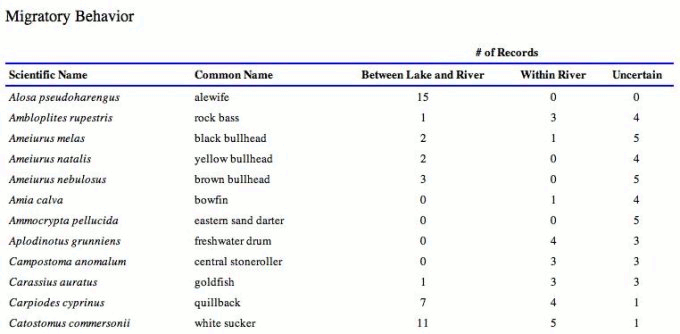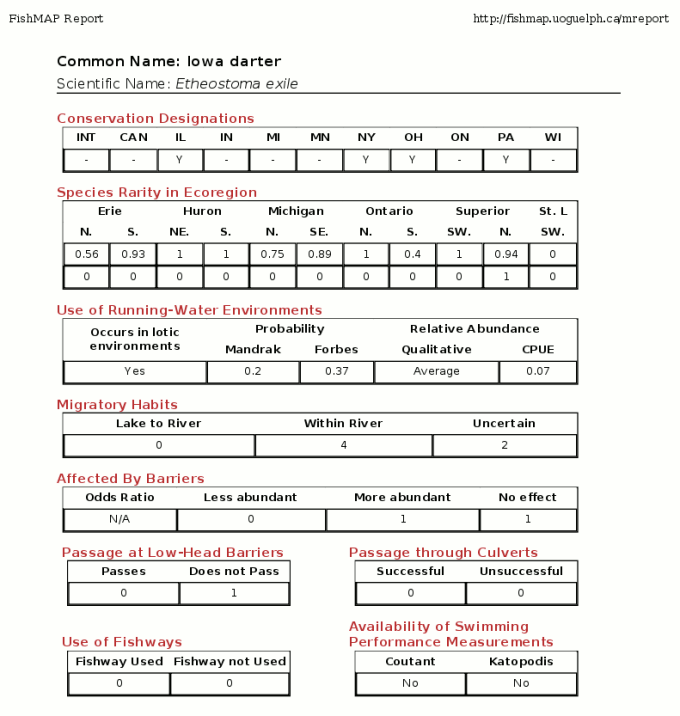About FishMAP
FishMaP stands for Fish Migration and Passage Knowledgebase. The website has two components: a fish distribution and passage component and a distribution mapping web atlas component. The distribution and passage component was developed to help scientists, fishery managers, and consultants within the basin of the Laurentian Great Lakes reach scientifically defensible decisions regarding the construction, modification, and removal of structures that can impede or facilitate in-stream movements of fishes. The atlas component was developed to help scientists, fishery managers, and consultants map biodiversity, including distributions of threatened, endangered, and invasive species. Figure 1 summarizes the categories of information accessible in FishMaP.

Figure 1. Conceptual organization of the information in FishMAP.
Mandrak et al. (2003) describes the different categories of conservation and passage information and how that information was compiled. Meixler et al. (2011) describes the geographic distribution and atlas information and how it was compiled.
How to Use FishMaP
Passage Component
Using the passage component entails specifying a species list through one of the five options provided in the main menu and then selecting the form and category of information desired. Once a species list has been selected, FishMaP provides two forms of report. The first form of report entails picking a topic from the categories in Figure 1 and summarizing information available on that topic for all selected species (species by topic report). An example is provided in Figure 2.

Figure 2. An example of a Species By Topic report.
The second form of report entails selecting a species of interest and summarizing for each species the information on each of the categories in Figure 1 (topic by species report). An example is provided in Figure 3.

Figure 3. An example of a Topics By Species report.
Additional details about specific entries in the reports can be obtained via information buttons and pop-up screens. Wherever possible, we have strived to make it easy for users to access the original source of the information. For some species and topics, the information is meager. In such instances, we sought information, as described in Mandrak et al. (2003). Absence of information means we did not find anything.
Atlas Component
Using the Atlas component entails choosing the Atlas tab near the top of the home page and selecting a species, by scientific or common name, to create a map displaying the tertiary watersheds in Canada and 8-digit HUCs in the US where the selected species is present or absent. Links at the bottom of the map can be used to acquire information regarding sources and to download copies of the maps in KMZ, JPG, and SHP formats. In addition, detailed source information by watershed can be obtained by clicking on particular watersheds in the map.
Acknowledgements
Project Development Team
» Rob McLaughlin, Department of Integrative Biology, University of Guelph, Guelph, ON, Canada N1G 2W1
» Nick Mandrak, Great Lakes Laboratory for Fisheries and Aquatic Sciences, Fisheries and Oceans Canada, 867 Lakeshore Road, Burlington, ON, Canada L7R 4A6
» Marci Meixler, 14 College Farm Road, Department of Ecology, Evolution and Natural Resources, Rutgers University, New Brunswick, NJ USA 08901
» Mike Jones, Quantitative Fisheries Center, Michigan State University, East Lansing, MI, USA 48824-1222
» Deb Stacey, Department of Computing and Information Science, University of Guelph, Guelph, ON, Canada N1G 2W1
Programming
» Jason Cote, Department of Computing and Information Science, University of Guelph, Guelph, ON, Canada N1G 2W1
» Hui (Grace) Shen, Department of Computing and Information Science, University of Guelph, Guelph, ON, Canada N1G 2W1
Data Compilation and Auditing
» Matt DeKar, Deb DePasquale, Derrick DeKerckhove, Rebecca Dolson, Bonnie Fraser, Michelle Farwell, Jonathan Freedman, Bill Harford, Feng Li, Ryan Marshall, Josh Noble, Lindzie O’Reilly, Milena Palka, Galya Sipos Randor, Katherine Smith, Sitai Sun, Jeff Zeyl
Funding and In-Kind Support
» Great Lakes Fishery Commission Science Transfer Program, Canada Foundation for Innovation, Ontario Innovation Trust, Fisheries and Oceans Canada, US Fish and Wildlife Service
|